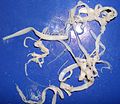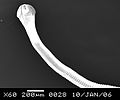Strobilation (redirect from Strobila)
near the upper extremity of the animal. A strobilating polyp is called a strobila while the non-strobilating polyp is called a scyphistoma or scyphopolyp...
4 KB (438 words) - 22:03, 30 October 2024
characteristic body differentiation pattern into scolex (head), neck, and strobila. The scolex, located at the anterior end, is a small (usually less than...
22 KB (2,059 words) - 23:30, 19 October 2024
one species. The adult tapeworm has a scolex (head), a short neck, and a strobila (segmented body) formed of proglottids. Tapeworms anchor themselves to...
38 KB (3,759 words) - 01:12, 31 October 2024
Pachysaga strobila is a species of insect in the family Tettigoniidae. It is endemic to Australia. Orthopteroid Specialist Group (1996). "Pachysaga strobila"....
936 bytes (47 words) - 02:10, 16 November 2023
stages: In Porifera: olynthus, gemmule In Cnidaria: ephyra, scyphistoma, strobila, gonangium, hydranth, polyp, medusa In Mollusca: paralarva, young cephalopods...
15 KB (1,378 words) - 09:41, 2 November 2024
body is white in colour and consists of three portions: scolex, neck, and strobila. The scolex has four suckers, but they have no hooks. Lack of hooks and...
19 KB (2,204 words) - 07:03, 28 August 2024
and long (180 μm) types. After a short neck is the elongated body, the strobila. The entire body is covered by a covering called a tegument, which is an...
38 KB (4,587 words) - 17:06, 1 November 2024
nervous system occurs in an organized, staged manner beginning in the strobila phase and results in bilaterally symmetrical organization of the organs...
13 KB (1,614 words) - 18:38, 6 April 2024
the intestinal wall, and the neck begins to bud off segments to form the strobila. New eggs usually appear in the feces of the definitive host within 6 to...
11 KB (1,334 words) - 00:56, 2 May 2024
tuning forks. The neck is long and slender, the region of growth. The strobila starts with short, narrow proglottids, followed with mature ones. Infection...
10 KB (1,382 words) - 15:47, 29 October 2024
which had a short strobila consisting of single immature and single gravid segments constituted the majority of the specimens. The strobila, rostellar hooks...
4 KB (345 words) - 10:23, 1 December 2023
portion of the body located behind the scolex and containing all of the strobila) may occur without any change in actual infection. Once shed, the proglotids...
5 KB (595 words) - 22:59, 1 August 2024
those species live have not been found. However, an asexually reproducing strobila form can sometimes live for several years, producing new medusae (ephyra...
119 KB (12,442 words) - 09:19, 2 November 2024
shape of a wedge with thick margins. Following the scolex is a narrowed strobila where the reproductive organs, nervous system and excretory system are...
12 KB (1,339 words) - 20:56, 5 November 2023
or with those in other worms. When the segment reaches the end of its strobila, it disintegrates en route, releasing eggs in a process called apolysis...
14 KB (1,774 words) - 04:15, 2 November 2024
small, medium and large – which are repeated throughout the length of the strobila (segmented body). The cuticle is thin and there are longitudinal and transverse...
5 KB (519 words) - 00:10, 16 April 2024
an unsegmented 'neck', and a highly segmented body proper called strobila. The strobila is composed of a chain of ribbon-like proglottids. The scolex bears...
7 KB (783 words) - 03:27, 26 April 2024
Oligotrichs Laboea strobila Scientific classification Domain: Eukaryota Clade: Diaphoretickes Clade: SAR Clade: Alveolata Phylum: Ciliophora Class: Spirotrichea...
4 KB (412 words) - 23:51, 14 May 2024
develops into a planula, then scyphistoma, then strobila, and finally a medusa. They cannot eat as egg or strobila. In other words, it only eats in every second...
8 KB (888 words) - 22:59, 4 April 2024
called 'strobila'. The scolex bears four suckers and a rostellum, which are the organs of attachment to the host. Individual segments in the strobila are...
9 KB (964 words) - 04:16, 7 September 2023
Meisn. (1840) Meneghinia Endl. (1839), nom. superfl. Munbya Boiss. (1849) Strobila G.Don (1837) Tetaris Lindl. (1868) Toxostigma A.Rich. (1850) Ulugbekia...
5 KB (326 words) - 03:40, 24 July 2024
unsegmented 'neck', and then by highly segmented body proper called strobila. The strobila is composed of a series of ribbon-like body segments called proglottids...
9 KB (997 words) - 20:39, 3 September 2023
were also found. A further nine oligotrich species were found: Laboea strobila, Strombidium acutum, S. dalum, S. wulffi and five unidentified Strombidium...
19 KB (2,279 words) - 16:43, 11 May 2024
of the small intestine and develop into mature strobila Echinococcus vogeli has the largest strobila within the Echinococcus genus, reaching a length...
9 KB (1,052 words) - 22:11, 30 October 2024
neck or growth region, and then by highly segmented body proper called strobila. The scolex is a bulbous knob-like structure bearing suckers and a rostellum...
16 KB (1,460 words) - 01:48, 17 October 2023
scolex, followed by a short neck and a highly extended body proper called strobila. It is an acoelomate animal with no body cavity or digestive system. The...
29 KB (3,548 words) - 01:20, 2 May 2024
It then develops into a free-living planula, then to a scyphistoma to a strobila, and finally into a free-living young medusa. "Pseudorhiza haeckelii, spec...
3 KB (291 words) - 07:57, 31 January 2022
which leads it to grow into a scyphistoma. This scyphistoma becomes a strobila, then finally becomes a young medusa. Reproduction for this species has...
6 KB (724 words) - 06:15, 12 February 2024
middlekaufi) Ixalodectes flectocercus Nanodectes bulbicercus Pachysaga strobila Imperiled grass false shieldback (Paracilacris periclitatus) Paradecolya...
16 KB (1,201 words) - 13:08, 30 August 2024
these develop into a free-living planula, then to a scyphistoma, to a strobila, and lastly to a free-living young medusa. S. malayensis is believed to...
6 KB (696 words) - 23:29, 17 October 2024
















